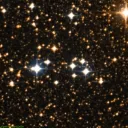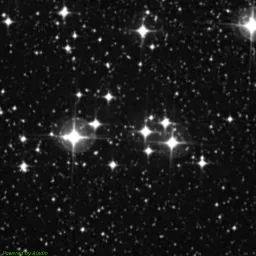NGC5662 Observation Details

NGC5662 Daily Motion
NGC5662 is said to be "never-rising." It is always below the horizon and remain out of view, regardless of the time of year or night.NGC5662 Visibility Timetable on December 15
NGC5662 Rise and Set Timetable
| Time | Elevation | |
| NGC5662 is always below the horizon | - | |
| Moon Rise, 26.2% illuminated | 00:23 | -37° |
| NGC5662 transit | 07:08 | -4° |
| Moon Set | 11:24 | -18° |
| Astrosession begin | 16:24 | -57° |
| Astrosession end | 03:41 | -13° |
Track NGC5662 Position Throughout the Night
← Mon, 15 December 2025 →
| Time | |
| Altitude | |
| Azimuth |
Where is NGC5662 right now?
NGC5662 is located in the constellation Centaurus, at right ascension 14h 35m 37s" and declination -56° 37' 05s. At the current time, it is below the horizon and not visible from your location.NGC5662 Image Gallery
DSS Blue

DSS Red

DSS Near-Infrared

DSS Composite image

The photos are taken from the Digitized Sky Survey 2 (DSS2), which was produced at the Space Telescope Science Institute (STScI) under NASA contract, using data from the UK Science and Technology Facilities Council (STFC), the European Southern Observatory (ESO), and the National Geographic Society-Palomar Observatory Sky Survey (POSS II).
Special thanks to the National Optical Astronomy Observatory (NOAO), the Royal Observatory, Edinburgh, and the California Institute of Technology for their significant contributions.
Finder Chart for NGC5662
| Object name | NGC5662 |
| Field of view | |
| Limiting magnitude | |
| NGC5662 coordinates | 14.59377, -56.61808 |
| Center coordinates | 14.59377, -56.61808 |
NGC5662 Passage Through Night
Current position of NGC5662
| Time | 13:53 |
| Latitude | 37.3541 |
| Longitude | -121.955 |
| NGC5662 elevation | -36° |
| NGC5662 Azimuth | 138° |
Annual motion of NGC5662
| Date | Mon, 15 December 2025 |
| Twighlight start | 16:20 |
| Twighlight end | 03:34 |
| Twighlight duration | 11h 15m |
| Rise | NGC5662 is always down |
| Set | NGC5662 is always down |
| Elevation at transit | -4° |
| Transit time | 07:05 |
| Equatorial coordinates | RA: 14h 35m 37s", Dec: -56° 37' 05s |
| Magnitude | 6 |
| Constellation | Centaurus |
The graph is structured with the vertical axis showing the hours of the day, ranging from 12 AM to 12 AM the next day, while the horizontal axis spans each day of the year.
The reddish shaded area indicates the periods when the NGC5662 is above the horizon, visible to observers. The white line marks the times when the celestial object reaches its highest point in the sky each day, known as the transit.
Astrometric & Physical Parameters of NGC5662
Coordinates & Visibility
| Right Ascension | 14.59377° |
| Declination | -56.61808° |
| Magnitude | 5.50 |
| Constellation | Centaurus |
| Elevation | -36.3° |
| Azimuth | 138° |
Data Credits
The nebulae information on this page is sourced from the OpenNGC project, developed by Matteo Verga. OpenNGC provides detailed data on the NGC catalog, which is a valuable resource for exploring deep-sky objects such as nebulae.
For more details or to contribute to OpenNGC, visit the official GitHub repository: OpenNGC on GitHub.
